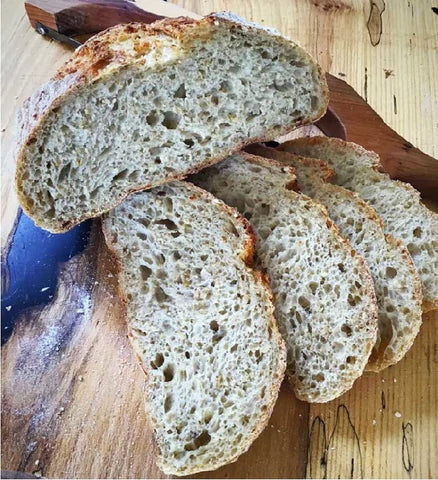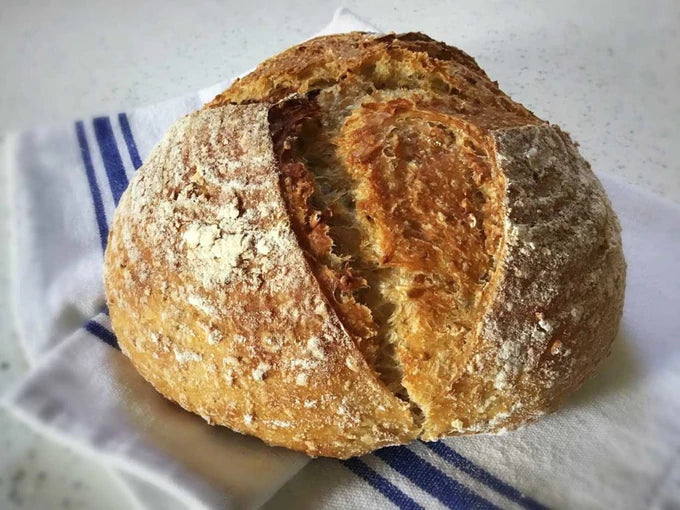Time: up to 24 hours; hands on time: 30 minutes.
Makes 1 small loaf
Essential equipment for this recipe: 17-18cm x 8.5cm deep banneton prepared with rice flour; ovenproof pan with lid



Time: up to 24 hours; hands on time: 30 minutes.
Makes 1 small loaf
Essential equipment for this recipe: 17-18cm x 8.5cm deep banneton prepared with rice flour; ovenproof pan with lid
300g Wychwood Oat blended flour
210g water
30g active starter
15g runny honey
1 tsp salt, or to taste
Wychwood Oat Blended Flour Baby Sourdough Loaf







Time: up to 24 hours; hands on time: 30 minutes.
Makes 1 small loaf
Essential equipment for this recipe: 17-18cm x 8.5cm deep banneton prepared with rice flour; ovenproof pan with lid
300g Wychwood Oat blended flour
210g water
30g active starter
15g runny honey
1 tsp salt, or to taste
This recipe makes a tasty soft loaf, with a slight chew from the oats in this lovely new flour. The mix starts off slightly sloppy but comes together to make a firm dough as the flour and oats absorb the water and the handling builds up structure.
Step 1: late afternoon/early evening, mix all of the ingredients together in your bowl to make a rough dough, with no dry flour showing, this will be a sticky, sloppy mix at this point. Cover the bowl with a shower cap or cover, and leave it for an hour or so on the kitchen counter.
Step 2: after this rest time, perform the first set of pulls and folds on the dough to build up its structure. Literally pick up a handful of dough from one side of the bowl, using your thumb and two forefingers to grab a portion, lift it, stretch it and fold it over the rest of the dough to the other side of the bowl, turn the bowl a few degrees and repeat the process; lift and fold, turn the bowl, lift and fold, turn the bowl… continue until the dough comes together into a smoothish ball. Then stop.
The dough will still be soft, it may only make a soft, loose ball, which is fine.
Cover the bowl again and leave it out on the kitchen counter. You can now leave the bowl again for an hour, or half an hour, whatever works for you before moving onto step 3.
Step 3: over the next few hours, at intervals that suit you, perform 3 more sets of the lifting and folding action, just enough to bring the dough into a ball; this is the dough telling you when it is time to stop. With each set of actions the dough will become firmer and more structured, leading eventually to a nice firm ball of dough. After each set, cover the bowl and leave it on the counter, doing the final set before going to bed.
Step 4: leave the covered bowl on the counter overnight to prove. I typically let my dough prove, untouched, for 8 to 10 hours at temperatures of 18-20C. If it is colder where you are it may require longer; if it is warmer, you will need to make amendments to the dough at the start of the process.
Step 5: the next morning you should have a bowl full of grown dough, look for it to double in size and have an almost smooth, slightly upwardly domed, textured surface, before moving to the next stage; sprinkle the inside of your banneton with an extra layer of rice flour and brush it round the inside To place the dough into the banneton, do a series of lifts and folds on the dough, enough to bring it into a firm ball again, then lift it into your banneton, smooth side down.
Cover the banneton with the same cover that you previously used for the dough, and place it in the fridge for 3 to 24 hours, to allow the dough to firm up and develop flavour.


Step 6: when you are ready to bake, you have two choices: to preheat the oven or bake from a cold start.
If you choose to preheat the oven, preheat it to 220°C fan assisted, or 240C non fan.
Have an enamel roaster or pan of your choice ready, plus good quality parchment paper.
Step 7: remove the cover from the banneton, place your parchment paper over the top of it, place the pan upside down over the top of them both. With one hand under the banneton and one hand on top of the pan, turn it all over together to turn the dough out and into the pan.
Step 8: with a lame or a clean razor blade, score the dome of the dough cleanly and firmly, at a depth of 0.5 to 1.0 cm.
Step 9: let’s bake!
If you preheated the oven, bake for 40 minutes, keeping the lid on for the entire time.
If you are baking from a cold start, place the pan in the cold oven, turn the temperature to 220°C fan, or 240C non fan, and bake for a total of 45 minutes from the time that you placed the pan in the cold oven, with the lid on the entire time.
After the 40 – 45 minutes, remove from the oven. Open the lid to check the loaf, if it looks pale, place it back in the hot oven, minus the lid, for 5 to 10 minutes to brown the loaf to the color of your choice.
Once the loaf is golden brown, carefully remove it from the pan, remove the parchment paper from the bottom, place the loaf to cool on a wire rack.
Step 10: leave the loaf on its rack to cool completely. Whichever route you took to bake your loaf, once it is cooling, wait at least 1 hour before you slice into it to eat it at its best. The baked loaf will have a crisp crust initially that will soften.
Why not try this as a larger loaf by scaling up all of the ingredients?
For more details, hints and tips, find Elaine at foodbodsourdough.com
← Older Post Newer Post →
Register your details for 10% off your first order and exclusive recipes, new product launches and exciting updates from the Cotswold Flour Baking Club.